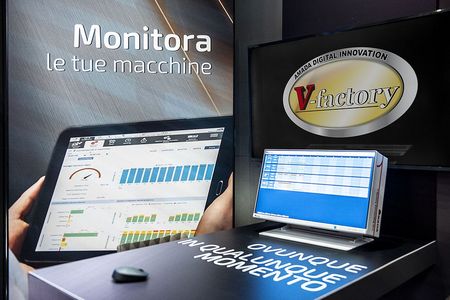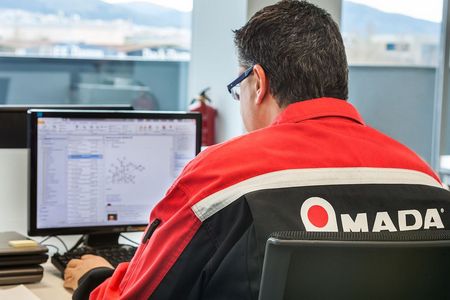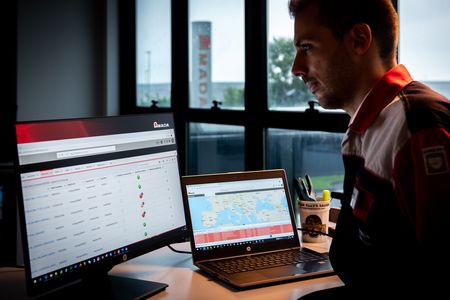Although Industry 4.0 is commonly thought as a concentrate of robotics, advanced automation and innovative human-machine interfaces, in reality the whole newly conceived industrial paradigm revolves around the interconnection of assets and the exploitation of data. The above mentioned technologies and considerations are grafted onto this system, but they are not the pillar of the model, rather some of its manifestations. The pillars, however, are all the tools and platforms that enable data acquisition within the industrial shopfloor, because without accurate information, transmitted and processed in real time, the concepts of interconnection and valorisation would make little sense.

AMADA, the 4.0 model and the role of the Internet of Things
AMADA has been investing for years in enabling an interconnected productive ecosystem, synthesized in the V-factory concept. The starting point of the route is undoubtedly the Internet of Things, the set of 'smart objects' and sensors capable of detecting and transmitting in real time operating conditions, load status of the machines, scheduling, electrical and material consumption and many other indicators/ KPI, enabling a level of control, optimization and flexibility of the production line never seen before. Let’s not forget that today manufacturers have to deal with increasingly tight times, micro-batches and constantly changing schedules: having production under control thanks to a data-driven approach does not only help to prevent failures and inefficiencies, but also to make the best decisions and to align with the market, building on this its own competitive advantage. Not only: if desired, data can be made available to customers in a just-in-time perspective, powering one of the sharpest trends in the manufacturing world (strengthened by the dynamics of new normal), that is the creation of supply chain and ecosystems more and more synergistic and connected.

Connection, analysis and data access: the pillars of V-factory
V-factory focuses on data acquisition, analysis and distribution. AMADA machines use the IoT to collect production and operation data, adjusting accordingly not to slow production rates and ensure compliance with quality requirements in the set times. The data is captured by CNC and then distributed via simple web interfaces, mobile applications from tablets or smartphones.
The AMADA architecture makes use of the cloud and takes full advantage of its benefits, including nearly unlimited scalability and 24/7 accessibility regardless of location and device: As a result, you can now control the production line from anywhere with a simple smartphone. Curiosity: this factor is (gradually) changing meaning to the expression smart working, which most companies associate with office automation, but in reality goes far beyond.
Thanks to the My V-factory software, it is possible to keep under control the single machines but also the progress of the entire production process: it includes data on the status of the machines (machining, setup, down time, alarm), whose analysis allows to identify any problems at the same or internal criticalities of the process; the workloads, with several KPIs related to the processing time, percentages, number of pieces and much more; the consumption of material and energy, also useful for understanding the efficiency of the machine and the process. All the analysis of the processing are very central, which, by linking pieces, lots, materials, tools and much more, can effectively draw an exhaustive picture of the state of production, on the trend of the processing as on the effectiveness and the efficiency of the same, allowing all the optimizations of the case. It should be noted, anything but secondary, that V-factory can be integrated with third-party systems, in the perspective of the global synergy of information that permeates the smart manufacturing model.

AMADA and Services 4.0: Predictive Maintenance and Remote Support
Part of the 4.0 paradigm are two applications and services that AMADA makes available to its customers: predictive maintenance and remote support, which are closely connected. The analysis of information and the use of the latest frontiers of data science allow AMADA to adopt a predictive maintenance approach, that is to minimize downtime by operating maintenance when really necessary and with the right notice. Again, this is enabled by (big) data and analysis techniques: an abnormal level of pressure or overheating can lead to a failure, which is predicted by the system with a reliable level of accuracy. In doing so, the company can move on time, not stop the machines, receive any spare parts and organize a maintenance without waiting for the fault and then have to bear the related costs.

Thanks to real-time data and connectivity, AMADA provides a remote service and predictive maintenance capable of extraordinary benefits for its customers. In addition to the "theoretical" ones related to the 24/7 remote monitoring of assets and the use of advanced analysis techniques, do not forget the essential value of the competence: AMADA provides remote assistance service, but is also the manufacturer of the machines and, above all, provides this service to many customers at the same time, deriving an unparalleled expertise.